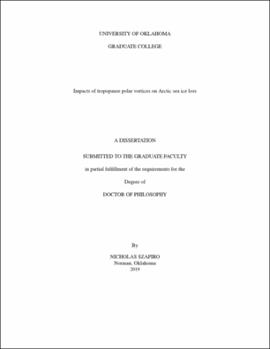| dc.description.abstract | The Arctic and sea ice cover play fundamental roles in the environment of the Earth system. Improved causal understanding of their changes is needed for meaningful predictions and planning. Among the linkages composing our understanding and predictions, hypothesized mechanisms and historical cases suggest that potentially long-lived, (sub-)synoptic coherent circulation features termed tropopause polar vortices (TPVs) can impact the evolution of Arctic sea ice on daily to seasonal time scales. Diagnostics and causal dynamical experiments are developed to evaluate whether there are mechanisms sufficient for TPVs to significantly impact Arctic summer sea ice loss.
A TPV's place, structure, and history are intimately related to its dynamics and associated impacts. A restricted regional watershed segmentation and major correspondence overlap TPV tracking method more robustly defines tracked TPVs' spatial structure (through restricted regional watershed basins with variable shapes and intensities) and time evolution (through similarity overlap with mergers and splits) relative to previous methods. Tracking with a more restrictive definition of lifetime and more robust, variable size, individual cyclonic TPVs can exceed radii of 1000~km, amplitudes of 40~K, and lifetimes of 2 months, coincide with multi-day extreme sea ice loss, and contribute seasonal-scale geographic anomalies.
To represent the potential, integrated impacts of TPVs on Arctic sea ice, it is argued that a comprehensive model should resolve TPVs and feedbacks with the larger polar circulation, consistently couple and realistically evolve sea ice, and be computationally tractable. Motivated by limitations in limited-area and coarser general circulation models to satisfy these requirements, the Model for Predictions Across Scales non-hydrostatic atmospheric dynamical core is embedded within the Community Atmospheric Model of the Community Earth System Model (CESM-CAM-MPAS). A global, Arctic-refined atmospheric configuration efficiently provides needed local resolution to TPVs with two-way feedbacks to the polar circulation. Coupling with an Earth system model evolves sea ice through process-based exchanges. With mixed historical and analog initial conditions intended to balance considerations of realism and consistency, summer simulations capture mean polar circulation anomalies and yield competitive September sea ice extent forecasts with skill for the sea ice edge. An effective, localized tendency-based modification strategy permits sensitivity experiments to quantify causal responses throughout the Earth system to input TPV perturbations.
Sensitivity experiments are conducted with directly modified TPV intensity within the coupled Earth system to causally explore and evaluate whether TPVs can have extreme sea ice impacts. Strong intensification of cyclonic TPVs in the Arctic can cause less summer sea ice loss. Multi-scale, thermodynamic, mechanical, and multi-component mechanisms contribute to differences in sea ice mass, momentum, and energy, with reduced upward surface ocean heat fluxes the largest of the factors associated with maintaining ice cover. The artificial intensification sufficient to realize sensitivity beyond expectations from historical and internal variability in individual simulations of July through September 2006 is near $-5$~K~d$^{-1}$. Larger than composite mean diabatic heating rates in TPVs, operational forecasts can exhibit initial forecast errors in TPV intensification of the same order.
Since large errors in individual vortices can change the trajectory of fundamental components of the simulated Earth system, characteristics and roles of TPV shape and place and integrated atmosphere-sea ice-ocean coupling emerge as important factors for linkages and predictions. Multi-scale, coupled system models offer one class of approaches that can provide qualitative depictions, quantitative sensitivities, and dynamical insights into relationships throughout the Earth system. The aggregated work motivates directions for future process and prediction studies. | en_US |
